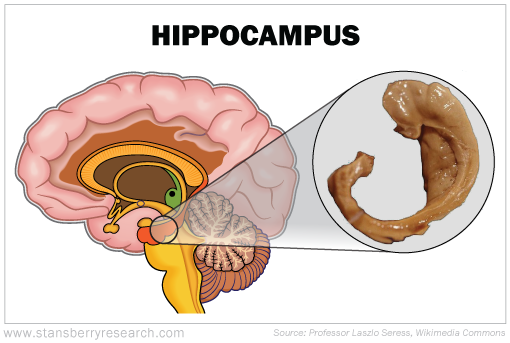I'm a bit of a dancing fool...
My passion started in childhood. Winters in Minnesota left me with little to do, so I chose to spend my time learning to dance. That was, after all, what all the pretty girls were doing, too.
By the time I reached senior year of college, I was teaching ballroom classes. Today, you'll find me hitting the dance floor at every holiday party and wedding. And I'm thinking of starting ballroom lessons with my gal sometime soon.
That's why I was interested to hear about a new study highlighting the physical benefits of dancing.
The study came from the German Center for Neurodegenerative Diseases in Magdeburg, Germany. Researchers separated participants into two groups: a traditional fitness group and a dancing group. Participants with an average age of 68 participated in their group activities for 18 months.
At the beginning and the end of the study, the scientists measured changes in participants' brains. They looked at a region called the hippocampus. This is the small, seahorse-shaped part of your brain that's responsible for balance as well as memory and learning.
After 18 months, the dancers not only had better scores in balance tests, but their actual hippocampi were larger.
The hippocampus is important because it's one of the first areas of the brain affected during the progression of Alzheimer's disease. Keeping it healthy and strong helps preserve memory as well as maintain balance.
Dancing in particular helps our brain health because it combines aerobic exercise with memory challenges (like routines) and motor skills. In this study, the researchers focused on jazz, Latin, square, and line dances.
But other research shows health benefits from ballroom dancing, which includes additional forms like swing, fox-trot, waltz, and tango.
In fact, a 21-year-long study published in the New England Journal of Medicine showed a link between dancing and dementia risk. They found that frequent dancers had a lower risk of dementia. That's compared with folks who engaged in other leisure activities like biking or swimming.
A research review in the International Journal of Gerontology showed dancing as a therapy for folks with mild to moderate Parkinson's disease. There's a growing body of research supporting the proposition that dance improves walking gait, posture, and balance.
Since posture is an important component of dancing, learning to build those muscles and step carefully improves gait. This is why dancing also helps prevent falls. A 2014 study out of Rio de Janeiro looked at nursing-care residents. Those who participated in a regular ballroom-dance program lowered their number of falls.
[optin_form id="73"]
Also, dancing helps improve our mood. The hippocampus shrinks when someone suffers from depression. Functional MRI images from women with depression showed the shrinkage clearly – the more episodes of depression, the smaller the hippocampus. So it makes sense that building up our hippocampus can help undo some symptoms of depression.
Additionally, dancing is by its nature, a very social activity. We've seen and written about previous studies linking loneliness and social isolation with Alzheimer's and inflammation. (You can read the full issue here.) And we know from experience that it's a great mood-booster and confidence-builder.
If you want to get started, check out different types of dance and see what appeals to you. Lower-impact classes like jazz, line dancing, waltz, rumba, and fox-trot are slower and good for beginners. If you're looking for more aerobic work, salsa, swing, square dance, and hip-hop are all great options. You can check out a full list of dances right here.
Finding dance classes doesn't mean shelling out hundreds a month for lessons (unless you really want the professional experience). Many assisted-living facilities offer classes for residents. You can also find them at your local senior center.
If you can't find a class offered, try contacting your county or state's department of aging. Similarly, local colleges and community organizations like the YMCA host dance classes.
Another tip: Ask around. My research assistant used to attend salsa nights at a local Brazilian restaurant that provided free lessons before a night of dancing. She found out about it through word of mouth. Similarly, we've seen community groups host dances like the American Legion, the Order Sons of Italy, and several religious organizations.
If you haven't given dancing a try, get out and get started today. Whether you're a seasoned dancer or just starting out, let us know your favorite type of dance right here: [email protected].
What We're Reading...
- Something different: Why do we keep banning books?
Here's to our health, wealth, and a great retirement,
Dr. David Eifrig and the Retirement Millionaire Daily Research Team
October 26, 2017

